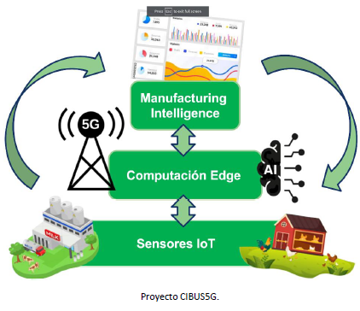Innovation Projects
CIBUS5G
Automation with 5G and AI for the Competitiveness of the Food Industry
CIBUS5G
The CIBUS5G project is included in the GRANTS FOR THE SUPPORT OF INNOVATIVE BUSINESS GROUPINGS WITH THE AIM OF IMPROVING THE COMPETITIVENESS OF SMALL AND MEDIUM-SIZED ENTERPRISES WITHIN THE FRAMEWORK OF THE RECOVERY, TRANSFORMATION, AND RESILIENCE PLAN | CALL 2024.
It is an industrial research project in digital technologies directly linked to Industry 4.0 that seeks to improve the competitiveness of the food sector in general, especially SMEs, and counts on 2 companies from the dairy and poultry sectors as early adopters in the project. This is achieved through the generation of new knowledge in enabling technologies such as Artificial Vision (AV), 5G, Edge Computing, IoT Data Capture, and Advanced Analytics with Artificial Intelligence (Manufacturing Intelligence). This new knowledge is geared towards the development of a new collaborative platform that integrates all these technologies to provide competitiveness tools to the food sector as a whole, given that all developments will be integrated into a solution that will have the necessary flexibility to adapt to any food use case.
The project consortium is composed of a total of 7 entities: 2 food companies, Leche Celta and Rosales Avícola (a large company and an SME, respectively), 3 technology companies, Optare Solutions, ASM Soft, and Logicmelt Technologies (all of them SMEs), and 2 IEGs (Innovative Enterprise Groupings), Clusaga as the applicant entity and DIHGIGAL as the collaborating IEG.
The project is divided into 7 Work Packages to be executed over the 12-month duration of the project: WP1 – Coordination (led by Clusaga), WP2 – Requirements and Architecture Definition (led by LECHE CELTA), WP3 – Development of Artificial Vision Solutions (led by LOGICMELT), WP4 – 5G Edge System for the Agri-food Industry (led by OPTARE), WP5 – Development of an Integrated Platform Equipped with Artificial Intelligence (led by ASM), WP6 – Validation of Results (led by Rosales), and WP7 – Dissemination (led by Clusaga).
Optare’s objective is to achieve the deployment of different network capabilities or slices for the same 5G private network deployment. For this, it will use an SA (Standalone) deployment, and different network capabilities will be designed to cover the areas of IoT processing on one hand and the sending of video information on the other. The communication channels established for each of these use cases will be provided through Network Slicing mechanisms, considering aspects related to their configuration and deployment, their SLA and associated assurance, and dynamic resource management actions. The slicing environment, in addition to providing differentiated network capacity, will associate different computing elements depending on the scenario. The effective deployment of Network Slices in a self-provisioning environment (10-20 MHz bandwidth) is a challenge in the deployment of 5G private SNPN (Standalone Non-Public Network) networks due to their use often requiring greater bandwidth.

The CIBUS5G project has been granted a subsidy for its execution associated with file AEI-010500-2024-191 of €30,019.00 by the General Directorate of Industrial Strategy and SMEs, in the exercise of the powers attributed to it by Order ICT/1117/2021, of 9 October, modified by Order ICT/474/2022, of 20 May, which establishes the regulatory bases for aid to support innovative business groupings with the aim of improving the competitiveness of small and medium-sized enterprises.

